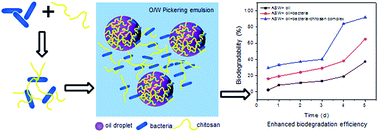Petroleum hydrocarbon degrading bacteria associated with chitosan as effective particle-stabilizers for oil emulsification†
Abstract
The effective emulsification of oil and retention of the stability of this emulsion in sea water is an important requirement for the remediation process following a marine oil spill. To identify alternate dispersants for emulsifying oil following a spill, we investigated oil-in-water emulsions stabilized by self-assembled complexes of a hydrophilic petroleum hydrocarbon degrading bacteria, Bacillus cereus S-1, with the linear polysaccharide chitosan. We found that the addition of chitosan improves the ability of hydrophilic Bacillus cereus S-1 to function as an effective emulsifier. The self-assembled complex of Bacillus cereus S-1 and chitosan is able to adsorb on the interface and stabilize oil-in-water emulsions for months. Confocal laser scanning microscope (CLSM) imagings and SEM results showed that the oil-in-water emulsions were stable against coalescence by formation of a thin film of bacteria–chitosan complex. Bacillus cereus S-1 associated with chitosan in the aqueous phase gave rise to a network, which was also responsible for the emulsion stability. The ability of this complex work in seawater was still very effective. In addition to stabilization, the addition of chitosan dramatically enhanced the oil degradation rate of Bacillus cereus S-1. Due to the sustainability and low environmental impact of chitosan and petroleum hydrocarbon degrading bacteria, this is an environmentally friendly and inexpensive way to treat marine oil spills.


 Please wait while we load your content...
Please wait while we load your content...